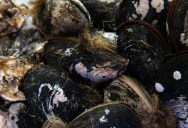Experts Say A Disturbing Amount Of Fiberglass Has Been Found In The Food Chain

People have been trying to raise the alarm about what’s actually in our food for decades now.
They’ve been vindicated by research into the harmful effects of red dyes and other additives, plus the existence of microplastics in just about everything we eat.
Now, the alarm is being raised about “disturbing amounts” of fiberglass found in the food chain.
The artificial material was recently detected in oysters and mussels along the south coast of the UK, and researchers believe this likely means it is an issue across the globe.

The oysters and mussels were collected by scientists at the University of Brighton and the University of Portsmouth, in an active boatyard in South England.
The fiberglass, or glass-reinforced plastic (GRP), was found in the oyster and mussels edible soft tissues – up to 11,220 fiberglass particles per kilogram in oysters and 2,740 particles per kilogram in mussels.
Dr. Corina Ciocan, a marine biology expert, issued a statement.
“Our findings show a disturbing level of GRP contamination in marine life. This study is the first of its kind to document such extensive contamination in natural bivalve populations. It’s a stark reminder of the hidden dangers in our environment.”
Fiberglass is tough yet lightweight, and has been a staple in the boat manufacturing industry since the 1960s.
Research shows that it can release tiny glass particles into the surrounding environment when the boat is crushed, dismantled, or repaired, though, and that contamination was higher in the winter, when many work on their boats.
Once the particles are in the water, they’re “sucked up” by filter-feeding bivalves like oysters and mussels. Because of the way they feed, these bivalves consume all kinds of microparticle contamination – including infectious pathogens and plastics.
The team believes the GRP contamination could harm or kill the shellfish.

Professor Kay Couceiro says they are now looking into whether or not they could travel up the food chain and impact human health.
“It’s a global issue, particularly for island nations with limited landfill space. Efforts are being made to find viable disposal solutions, but more needs to be done to prevent at-sea dumping and onshore burning.”
We’re just starting to understand how this happens and how prevalent it is across the world.
Soon, though, we might suffering the effects ourselves.
If you thought that was interesting, you might like to read about why we should be worried about the leak in the bottom of the ocean.

Sign up to get our BEST stories of the week straight to your inbox.




